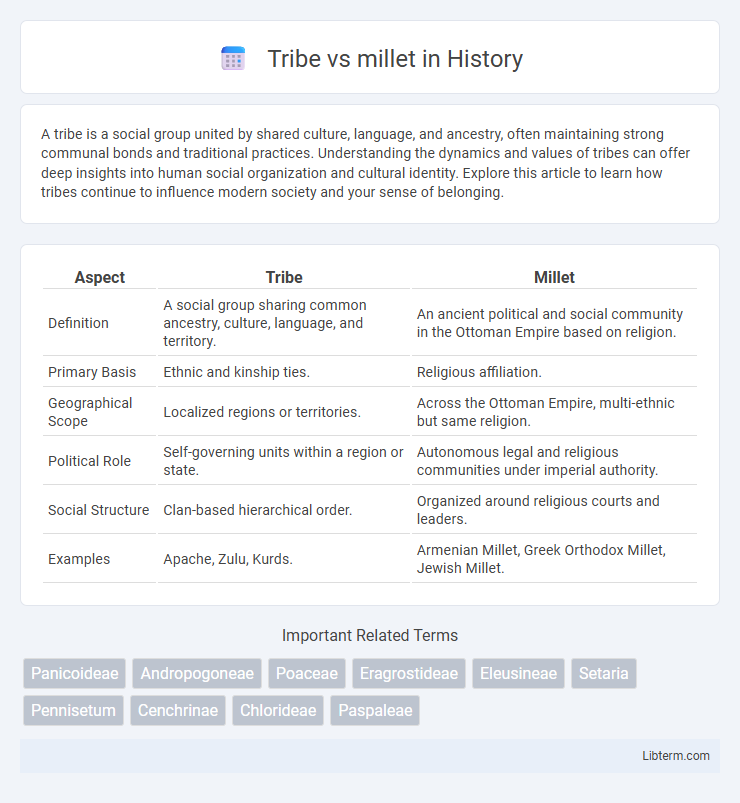A tribe is a social group united by shared culture, language, and ancestry, often maintaining strong communal bonds and traditional practices. Understanding the dynamics and values of tribes can offer deep insights into human social organization and cultural identity. Explore this article to learn how tribes continue to influence modern society and your sense of belonging.
Table of Comparison
| Aspect | Tribe | Millet |
|---|---|---|
| Definition | A social group sharing common ancestry, culture, language, and territory. | An ancient political and social community in the Ottoman Empire based on religion. |
| Primary Basis | Ethnic and kinship ties. | Religious affiliation. |
| Geographical Scope | Localized regions or territories. | Across the Ottoman Empire, multi-ethnic but same religion. |
| Political Role | Self-governing units within a region or state. | Autonomous legal and religious communities under imperial authority. |
| Social Structure | Clan-based hierarchical order. | Organized around religious courts and leaders. |
| Examples | Apache, Zulu, Kurds. | Armenian Millet, Greek Orthodox Millet, Jewish Millet. |
Understanding the Terminology: Tribe vs Millet
A tribe refers to a social group united by common ancestry, language, culture, and often territorial affiliation, typically characterized by shared customs and governance structures. A millet, historically used in the Ottoman Empire context, denotes a legally recognized religious community with autonomous self-government under its own religious leaders, blending ethnic and religious identity. Understanding the terminology requires recognizing that tribes emphasize kinship and cultural bonds, while millets focus on religious organization and legal autonomy within a multi-ethnic empire.
Historical Roots of Tribe and Millet
Tribes and millets both have deep historical roots in socio-political organization, with tribes typically forming through kinship ties and shared cultural identity among indigenous groups, while millets originated as administrative units in medieval agrarian societies, particularly in the Ottoman Empire, where they represented religious communities granted autonomous governance. Tribes often maintained oral traditions and distinct social structures predating formal state systems, whereas millets institutionalized communal autonomy within larger imperial frameworks, shaping religious and ethnic diversity management. The historical development of tribes reflects localized social cohesion, contrasting with millets' role in codifying multi-faith coexistence under centralized authority.
Social Organization: Contrasts and Connections
The social organization of tribes is typically based on kinship ties and lineage groups, emphasizing close family relationships and clan structures that govern social roles and responsibilities. Millets, as administrative divisions during the Ottoman Empire, organized populations primarily on a religious basis, grouping communities by faith rather than kinship, which allowed for religious autonomy under the state's legal framework. While tribes focus on consanguineous bonds and local leadership, millets represent institutionalized pluralism, highlighting the contrasting foundations of social cohesion and governance.
Governance Structures in Tribes and Millets
Tribes typically operate under kinship-based governance structures, where authority is vested in elders or hereditary chiefs who make decisions through consensus or customary law. Millets, as agrarian communities, often employ a more organized system with defined roles such as village councils or panchayats that manage local resources and dispute resolution. Both governance models emphasize community participation but differ in formality and institutional complexity, reflecting their distinct social and economic arrangements.
Cultural Identity and Group Cohesion
Tribes maintain cultural identity through shared customs, language, and rituals that reinforce a strong sense of belonging and hereditary lineage, fostering tight-knit group cohesion. Millets, historically based on religious or linguistic affiliations within larger empires, emphasize collective identity through communal worship and social norms, enhancing unity among diverse populations. Both systems function to preserve cultural heritage and social order but differ in their basis of group organization and collective identity.
Role of Religion and Tradition
In tribes, religion and tradition are deeply intertwined, forming the core of social identity, governance, and daily rituals, often guided by animistic or ancestral beliefs. Millets, as larger agricultural communities, integrate religion into more formalized social structures and rituals, reinforcing community cohesion and legal systems. Both emphasize tradition to preserve cultural heritage, but tribes rely more on oral transmission while millets develop codified religious practices.
Economic Systems: Subsistence and Trade
Tribes primarily rely on subsistence economies, engaging in hunting, gathering, and small-scale agriculture to meet their immediate needs. Millets, as early agrarian communities, practiced more advanced agricultural techniques, producing surplus crops that enabled trade and the development of early market economies. The transition from tribal subsistence to millet-based surplus production marked a significant shift toward complex economic systems involving exchange and resource management.
Conflict Resolution in Tribe and Millet Societies
Conflict resolution in tribe societies often relies on customary laws and communal consensus, where elders or chiefs mediate disputes through traditional rituals and negotiation, fostering social cohesion. Millet societies typically employ religious authorities and codified legal frameworks, integrating spiritual and judicial processes to resolve conflicts and maintain order. Both systems emphasize collective responsibility and restorative justice, but tribes prioritize oral tradition and interpersonal mediation, while millets utilize formal institutions and documented regulations.
Evolution and Modern Relevance
Tribes evolved as kin-based social groups with shared customs and governance rooted in ancestral lineage, while millets represent agrarian communities centralized around crop cultivation and economic networks. Tribal structures influenced early societal organization through decentralized leadership, contrasting with millets' role in fostering regional trade and cultural exchange. Modern relevance of tribes persists in preserving indigenous knowledge and cultural identity, whereas millets gain renewed importance for sustainable agriculture and food security in contemporary economies.
Comparative Analysis: Tribe vs Millet
Tribes are social groups characterized by shared ancestry, culture, and governance often tied to specific geographic regions, whereas millets are small-seeded grasses cultivated primarily for food and fodder. Tribes contribute to cultural diversity and social organization, influencing regional history and identity, while millets serve as resilient staple crops with high nutritional value and adaptability to arid climates. The comparative analysis highlights the distinction between tribes as human sociocultural units and millets as agricultural produce essential for food security and sustainability.
Tribe Infographic

 libterm.com
libterm.com